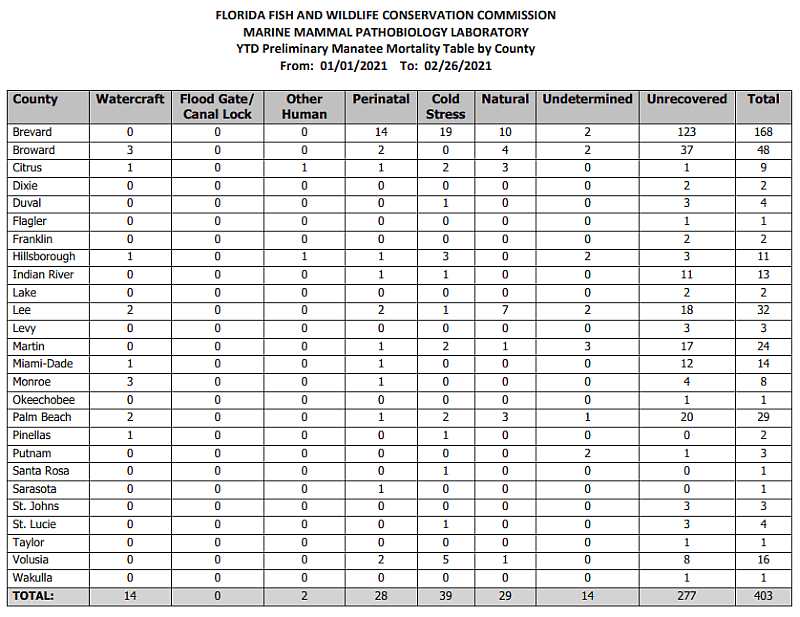IRLNews:2021-03-07/Indian River Lagoon Manatee Mortality
From Indian River Lagoon Project
Indian River Lagoon Manatee Mortality
March 7, 2021
Indian River Lagoon -
The Indian River Lagoon's population of West Indian Manatees are dying at an alarming rate. Florida normally averages 129 manatee deaths a year, but as of February 26th, 403 deceased manatees have already been reported to the Florida Fish and Wildlife Conservation Commission (FWC) in 2021.[1]
A record 254 (63%) of Florida's total reported manatee deaths were within the Indian River Lagoon National Estuary watershed.[2]
- Volusia = 16
- Brevard = 168
- Indian River = 13
- St. Lucie = 4
- Martin = 24
- Palm Beach = 29
Why does Brevard County have more manatee deaths than any other county in Florida?
There are several factors affecting Brevard's manatee population. All from Human Impact:
- Natural Migration Interruption - There are an abnormal amount of manatees in the Port St. John's area of the North Indian River Lagoon due to the warm water discharge from the coal powered Florida Power and Light Plant. Manatees would normally migrate south as the temperature drops but the power plant's warm water outflow distracts them from their natural migration. During the winter Port St. John's manatee population easily exceeds 500 individuals.
- Loss of seagrass - It is estimated that the Indian River Lagoon has lost over 60% of the record high seagrass coverage recorded in 2005. Nutrient pollution from vehicle emissions, aging septic/sewer systems, and fertilizer in stormwater has increased the levels of Nitrogen and Phosphorus in the estuary. These excessive nutrients feed the spring algae blooms, which cloud the water and block the sun, which causes the seagrass to die. Manatees eat up to 10% of their body weight daily and there just isn't enough seagrass in the North IRL to feed the unnaturally large population.
- Loss of habitat - Most of Brevard's shoreline's are lined with seawalls or impoundment dike roads, there isn't much living shoreline remaining. Manatees have been known to eat shoreline vegetation in Brevard's residential canals, but they can't climb the lagoon's embankments to reach it.
- Compartmentalization - There are eight earthen berm causeways across the Northern Indian River and 5 across the Banana River. These berms are dams that block 80% or more of the lagoon's width. Only a small percentage is open water spanned by Intracoastal Waterway bridges. Having a causeway every few miles is compartmentalizing the Banana and Indian Rivers. Each compartment has it's own feeders, tributaries, drainage canals and saltwater inflows. Some compartments have no inflows at all. The water in some of these IRL compartments has a very low water exchange rate, so what happens in these compartments may remain for over 200 days. The Titusville to Port St. John compartment of the IRL recently received a 7 million gallon sewage spill that may take months to fully dissipate.
Web Links
Documents
- FWC 2021 Preliminary Manatee Mortality Table (PDF 14pp 562KB)
- FWC 2021 YTD Manatee Mortality Table (PDF 1p 113KB)
References
- ↑ FWC 2021 Preliminary Manatee Mortality Table (PDF 14pp 562KB), retrieved on 2021-03-07.
- ↑ FWC 2021 YTD Manatee Mortality Table (PDF 1p 113KB), retrieved 2021-03-07
Location: Estuary: Indian River Lagoon: Florida East Coast
Source:
Retrieved on March 07, 2021.
Topic: Wildlife



